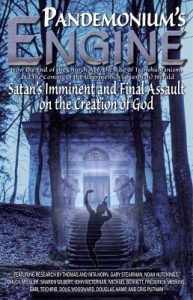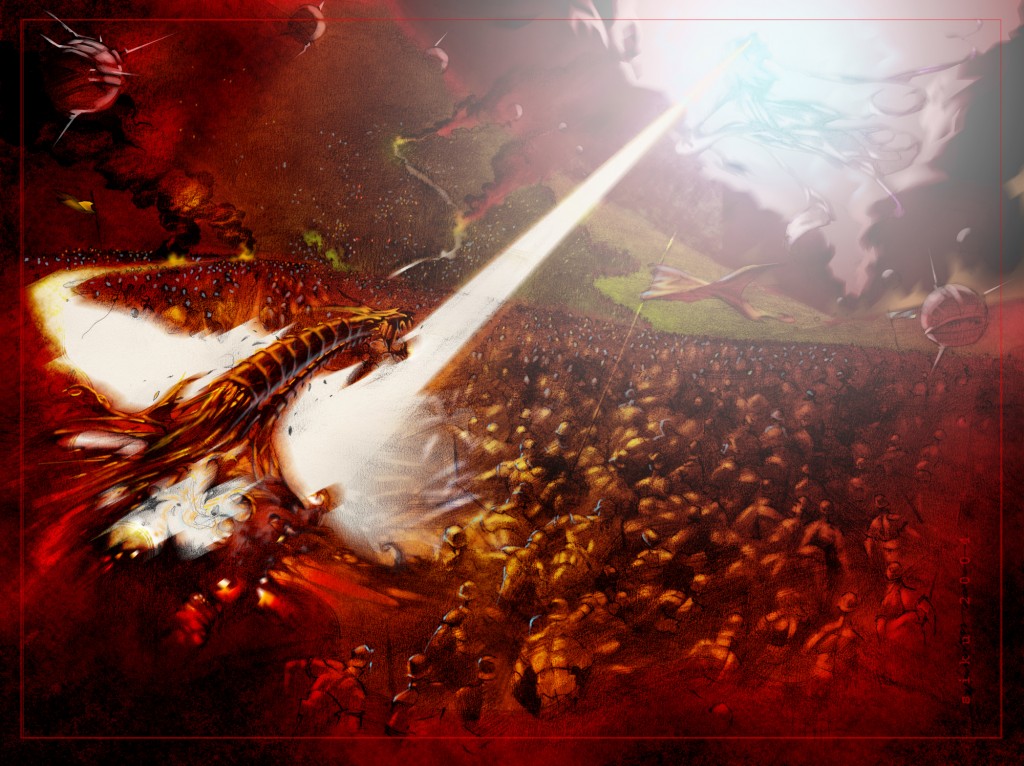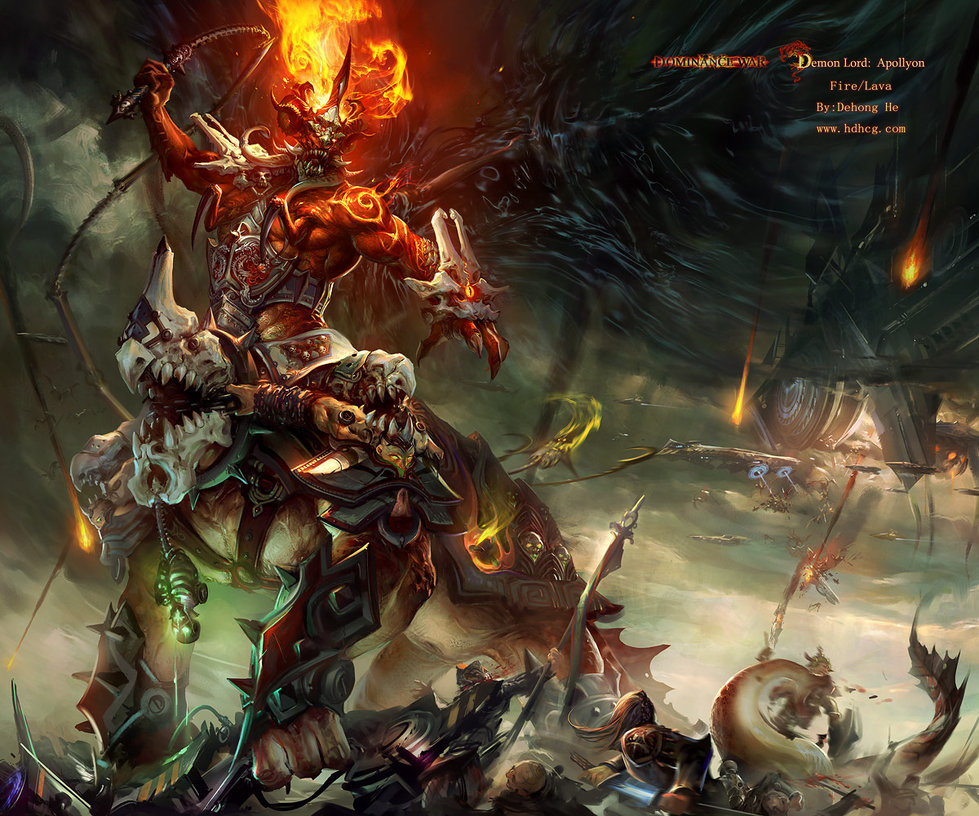THE BATTLE
The Antichrist figure finds his counterpart in the Hebrew Bible as Gog in Ezekiel 38-39. To demonstrate this point, a brief examination of the name גּוֹג Gog is required. In Ezekiel, Gog is clearly the enemy of Israel from the land of Magog or possibly “from the land of Gog.” In scripture, the proper names Agag and Gog were rendered somewhat interchangeably from the Hebrew. For instance, Agag appears in 1 Samuel: “And he took Agag the king of the Amalekites alive and devoted to destruction all the people with the edge of the sword”(1 Sa 15:8). He was the King of the Amalekites, a nephilim tribe, who was defeated and spared by Saul, but later killed by Samuel. It is interesting that the Septuagint translators rendered the name “Gog.” Yet, modern translations render it Agag. For instance, Numbers 24:7 which is a poetic oracle by Balaam concerning Israel and how they have God’s favor.
Remember, Balaam was a sorcerer hired to curse Israel but his diabolical efforts were frustrated by God. Thus, in the traditional rendering, the context is appropriate that Israel’s king will be superior to Gog. For instance,the ESV renders it,“Water shall flow from his buckets, and his seed shall be in many waters; his king shall be higher than Agag (Gog), and his kingdom shall be exalted”(Nu 24:7). Well enough, this traditional rendering of the prophecy is assuredly concerning Saul’s defeat of Gog, nephilim king of Amalekites. Yet strangely the LXX translation by Brenton reflects a different manuscript which makes it seem as if Gog is from Jacob’s seed:
And Balaam lifted up his eyes, and sees Israel encamped by their tribes; and the Spirit of God came upon him. And he took up his parable and said, Balaam son of Beor says, the man who sees truly says, he says who hears the oracle of the Mighty One, who saw a vision of God in sleep; his eyes were opened: How goodly are thy habitations, Jacob, and thy tents, Israel! as shady groves, and as gardens by a river, and as tents which God pitched, and as cedars by the waters. There shall come a man out of his seed, and he shall rule over many nations; and the kingdom of Gog shall be exalted, and his kingdom shall be increased. ( Num 24:5-7 LXX Benton 1851 )[1] (emphasis added)
The kingdom of Gog will be exalted? This is astonishing! Is this just a bad translation or could this reading infer the sorcerer Balaam was predicting the kingdom of Antichrist? Many have speculated he must be Semitic for the Jews to accept him as Messiah. Balaam is an odd character for a pagan sorcerer as he also predicted Christ and the star of Bethlehem in his final oracle (Num 24:17). The prophetic literature gets even stranger.
Missler makes reference to the name Gog being used in the Septuagint while drawing a parallel to its use Ezekiel and Revelation. The LXX Translation by Brenton 1851 renders, “Thus has the Lord God shewed me; and, behold, a swarm of locusts coming from the east; and, behold, one caterpillar, king Gog” (Am 7:1). The original context of this passage is that judgment is coming to the Northern kingdom, Israel. It is a vision given to Amos of a locust army invasion similar to that in Joel. Yet, Amos begs the Lord to repent of it and the Lord does not carry it through (cf. Am 7:3). The thing that makes this use of Gog distinct is that it is not a variant translation from the Masoretic text because the Masoretic uses no name at all. See a comparison here. Missler draws significance from juxtaposing “locusts have no king” (Pr 30:27) against the “locusts” in Amos and Revelation who do have a king, arguing that it implies Amos and John must not be talking about insects:
The locusts in Revelation 9 have a king, Apollyon or Abaddon, but Proverbs 30:27 says that locusts have no king. So these locusts are not natural locusts; they are demon locusts. If that’s the case, then Gog, who is the king of the locusts, is a demon king.[2]
While the purpose of proverbs was not entomology, this reasoning seems quite reasonable. The terms grasshopper and locust are interchangeable as their is no taxonomic difference between locust and grasshopper species. In English the term “locust” is used for grasshopper species that change morphologically and behaviorally to form swarms. Research at Oxford University has identified that swarming behaviour is a response to overcrowding. Clearly the prophet is using locusts and caterpillar symbolically for invading hoards. The ancient Israelites had an agrarian economy. Invading armies are destructive to cities as insects are to crops. It implies annihilation. In the case of Amos’s original context, it would be the Assyrians who did in fact completely destroy the Northern kingdom. But the future context of Revelation speaks of a devastation by demonic entities.
Yet the only use of the proper name Gog in the NT appears in the book of Revelation and applies to a war after the millennium when Satan is released after being bound for 1,000 years. The locust imagery also recalls imagery from the book of Revelation 9 and the locust army of Joel:
In appearance the locusts were like horses prepared for battle: on their heads were what looked like crowns of gold; their faces were like human faces,(Re 9:7)
Their appearance is like the appearance of horses, and like war horses they run. As with the rumbling of chariots, they leap on the tops of the mountains, like the crackling of a flame of fire devouring the stubble, like a powerful army drawn up for battle.(Joe 2:4–5)
The two passage must refer to the same event because their really can be only one ultimate Day of the Lord. The locusts/war horses here are thought to represent the demon hoards who attack during the tribulation. The descriptions harken chimeric monstrosities. Tom Horn explores possible biotech avenues for making these monsters a reality in his books Apollyon Rising and Forbidden Gates. In the former he ponders Joel’s insectoid horde:
When the numerous ancient texts from inerrant Scriptures to extra-biblical sources are added up, there is persuasive evidence that Joel’s army could indeed be more than simple grasshoppers, and that this massive Gibborim army that runs upon the wall from which nobody can escape could be the result of man’s willingness to play “god” in reviving forbidden science and opening “gates” to what lurks beyond.[2a]
Others see what is widely believed to be “aliens” also taking part in this scenario. There does seem to be cultural trend toward belief in extraterrestrial life. It seems a likely cover story for demonic entities. In fact, the entities that gather the worlds armies for the battle of Armageddon bear an uncanny resemblance to what are commonly believed to be aliens.
“And I saw, coming out of the mouth of the dragon and out of the mouth of the beast and out of the mouth of the false prophet, three unclean spirits like frogs. For they are demonic spirits, performing signs, who go abroad to the kings of the whole world, to assemble them for battle on the great day of God the Almighty.(Re 16:13–14)
Many believe this is the strong delusion mentioned by Paul (2 Thes 2:11). Dr. David Allen Lewis and Robert Shreckhise postulate that these demonic spirits that look like frogs are indeed what the popular media deems “greys.” [2b] Paradox Brown carries this line of thought a little further offering:
But note that John doesn’t say the three evil spirits “ARE three frogs”. He says they “looked like frogs”… Let’s say that John was shown in his Revelation vision an image of something he had never seen before… It makes sense that if John didn’t know what this creature was, and had never seen anything like it, that he would describe it as “looking like” something he was familiar with. [2c]
Thus, it appears we have a menagerie of insectoid and reptilian transgenic entities involved in the Armageddon scenario. The secular world will likely assume they are from outer space as they have been heavily propagandized in that direction. We can infer that since Gog is the “caterpillar king” of this army, he is likely one and the same as Apollyon or Abaddon (cf. Am 7:1 LXX ; Rev 9:11). It seems likely that Gog in Ezekiel 38 & 39 is the Satanically empowered general in the end time war, the Beast.
Much has been written associating the Magog war of Ezekiel 38-39 with the battle of Armageddon. There are demonstrable parallels yet seemingly the book of Revelation explicitly places it one thousand years after Armageddon (cf. Rev 19:19; Rev. 20:8 ). Amillennialists (those who deny the 1000 year kingdom) like Kline attempt to conflate the battles described in Revelation 19 and 20.[3] Yet this lacks coherence as Heiser points out several insurmountable difficulties to this view. [4] Still, both Kline and Heiser agree that Gog can be associated with the Antichrist. This finds support in the Qumran War Scroll (1QM), which reveals it is Satan and his powers that are behind the usurpers:
For this shall be a time of distress for Israel, [and of the summons] to war against all the nations. There shall be eternal deliverance for the company of God, but destruction for all the nations of wickedness. All those [who are ready] for battle shall march out and shall pitch their camp before the king of the Kittim and before all the host of Satan gathered about him for the Day [of Revenge] by the Sword of God.[5]
The Qumran War Scroll reflects the same end time war as the Ezekiel text and accredits it to Satan. However, in Revelation 20 the Antichrist has been defeated and what is described is the release of Satan. Heiser convincingly solves this by viewing Gog as both. He writes, “I have argued that Ezekiel 38-39 will be fulfilled in two events: (1) Armageddon, which also is the fulfillment of Daniel 11:40-45; and (2) The subsequent, separate battle of Rev. 20:7-9.”[6]
“He shall come into the glorious land. And tens of thousands shall fall, but these shall be delivered out of his hand: Edom and Moab and the main part of the Ammonites.(Da 11:41)
“And when the thousand years are ended, Satan will be released from his prison and will come out to deceive the nations that are at the four corners of the earth, Gog and Magog, to gather them for battle; their number is like the sand of the sea.(Re 20:7–8)
Thus the Satanically possessed Beast of Revelation is Gog in the battle of Armageddon and Satan himself is Gog in the post-millennium war. While Heiser argues that the Magog war is fulfilled in two stages of the “already but not yet” fulfillment scenario, this present treatment suggests a similar but novel solution.
One of the better arguments against placing the Magog war prior to the tribulation as many traditional dispensationalists do as well as against the recapitulation view of Amillennialists is that Ezekiel 38 describes Israel as already completely regathered in the land (Eze 38:8, 12) and dwelling securely without defenses (Eze 38:11).[7] This certainly does not apply to Israel’s current situation or to the preconditions for the battle of Armageddon. Today Israel is under constant threat and has very real barrier walls. It is also inconsistent with Armageddon because it is in the latter part of the great tribulation. Surely after enduring the trumpet and bowl judgments they will not be together in a secure peaceful state. Furthermore, the dry bones prophecy of Ezekiel 37 describes Israel’s rebirth contingent with the Messiah (Eze 37:15-28). Interestingly, Ezekiel 39:28 is a world wide call to Jews to return from the diaspora. Accordingly, it seems that chapter the 39 war precedes what is described in 38. Only after Ezekiel 39:28 will the diaspora be completely undone and the nation at peace. While others have postulated an earlier Psalm 83 war, The Ezekiel 38 war makes more sense in light of it being post millennium exactly as it says in Revelation 20. The biblical text solves the problem without an extra war. Thus, I completely agree with Heiser that Ezekiel 38 is the satanic showdown after the millennium. However, from this point forward an alternative interpretation is offered.
It is the proposal here that Ezekiel 39 describes the battle of Armageddon which temporally precedes the Magog war of chapter 38. The prophetic books are in a state that makes it extremely challenging to determine where one oracle ends and another begins. The modern chapter divisions are arbitrary and were imposed during the thirteenth century AD. While, the traditional view is that chapter 39 is restatement of 38, this is a tacit acknowledgement that chapter 38 resolves satisfactorily.[8] In other words, because they are both complete units and not dependent upon each other, they can arguably represent distinct battles. In Ezekiel 38, some of the Nations question and do not battle (Eze 38:13) but at the battle of Armageddon (Zec 14: 12) it seems all the nations of the world will be gathered against Jerusalem. The Ezekiel 39 battle is addressed to all the nations (Eze 39:7). Furthermore, chapter 39 is inaugurated with a new “Thus says the Lord God.” This interpretation suggests that chapters 38-39 are two distinct wars for the following seven reasons: One, Gog and his armies are described as brought out to battle at the beginning of each chapter in unique circumstances (38:4-9; cf. 39:2). Two, chapter 38 clearly states that the land was restored from war (Ez 38:8). It is suggested that this refers to the Ezekiel 39/Armageddon war. Three, the chapter 38 war ties together with the post millennium release of Satan (Rev.20:7-10; cf. Eze 38:16, 22) and the white throne judgment (Rev.20:11-15) with “I will enter into judgment with him” (Eze 38:22). Four, the nations will know that their defeat was by the Lord and that Israel will know the Lord from that day forward (Eze 39:21-22). This arguably convenes the inauguration of the millennium. Five, the nations will understand why Israel was exiled and abandoned by God (Eze 39:23). This explains the tribulation. Six, the Lord will restore and gather Israel (Eze 39:25-27). This seems to be concurrent with the return of Christ in Ezekiel 37:15-28 and is a precursor to the chapter 38 war. Seven, Israel knows their God from that day forward and God never hides his face from them again (Eze 39:28-29). Consequently, the prerequisite regathered and secure status of Ezekiel 38 (Rev. 20) is arguably the result of the previous Ezekiel 39 (Rev. 19) war. All that is required for one to accept is that these are two oracles in a non-chronological order, a contention which is hardly unprecedented.
It is also compelling that in the Ezekiel 39 war, Gog is described as coming “from the uppermost parts of the North” and “against the mountains of Israel” (v.2). This language strongly concurs with the “mount of assembly in the far reaches of the north” interpretation of Armageddon. Brevard Childs’ scholarship on the enemy from the north and the chaos tradition suggests a possible connection:
Isa 14:12 ff. is a taunt against the king of Babylon and not directly related to the enemy tradition. Nevertheless, it is quite remarkable that the king who dared to “sit on the mount of assembly in the far north is described as the one “who made the earth tremble, who shook kingdoms.”[9]
It may be helpful to view this as cosmic north referring generally to the supernatural realm. In the aftermath, Gog falls on the mountains of Israel. In light of the case for supernatural warriors, it is interesting to note the distinction made between his hordes and people (Eze 39:4). In other words, his hordes are not necessarily human. There is a massive feast of carrion for the birds (39:4; cf. 17-20) which is correlated directly with Revelation 19:17-19. This also finds a parallel in Isaiah 18 and oracle addressing the inhabitants of the world (Is 18:3) and which culminates with the inauguration of Gods’ millennial kingdom (Is 18: 7ff).
| Isaiah 18 | Ezekiel 39 | Revelation 19 |
| “They shall all of them be left to the birds of prey of the mountains and to the beasts of the earth. And the birds of prey will summer on them, and all the beasts of the earth will winter on them.”(Is 18:6) | “You shall fall on the mountains of Israel, you and all your hordes and the peoples who are with you. I will give you to birds of prey of every sort and to the beasts of the field to be devoured.(Eze 39:4)“As for you, son of man, thus says the Lord God: Speak to the birds of every sort and to all beasts of the field, ‘Assemble and come, gather from all around to the sacrificial feast that I am preparing for you, a great sacrificial feast on the mountains of Israel, and you shall eat flesh and drink blood.” (Eze 39:17) | “Then I saw an angel standing in the sun, and with a loud voice he called to all the birds that fly directly overhead, “Come, gather for the great supper of God, to eat the flesh of kings, the flesh of captains, the flesh of mighty men, the flesh of horses and their riders, and the flesh of all men, both free and slave, both small and great.” And I saw the beast and the kings of the earth with their armies gathered to make war against him who was sitting on the horse and against his army.(Re 19:17–19) |
There is only one time on the prophetic timeline in which one could say that God will reveal himself to all the nations and no longer tolerate his name being profaned (Eze.39:7; cf. Rev. 19:15). There is really only one day that he will regather all of Israel to their land while pouring out his spirit (Eze.39: 29; cf. Joel 2:28). Because these things are established “from that day forward”(Eze 39:22), this war will necessarily conclude just prior to the Millennium (Rev 20:4). That necessitates that this war happens on the narrow sense Day of the Lord, Armageddon or the battle of Har Mô∙ʿēḏ – the Cosmic Mountain of God.
Blow a trumpet in Zion; sound an alarm on my holy mountain!
Let all the inhabitants of the land tremble, for the day of the Lord is coming;
it is near, a day of darkness and gloom, a day of clouds and thick darkness!
Like blackness there is spread upon the mountains a great and powerful people;
their like has never been before, nor will be again after them through the years of all generations.
Fire devours before them, and behind them a flame burns.
The land is like the garden of Eden before them, but behind them a desolate wilderness,
and nothing escapes them.
Their appearance is like the appearance of horses, and like war horses they run.
As with the rumbling of chariots, they leap on the tops of the mountains,
like the crackling of a flame of fire devouring the stubble,
like a powerful army drawn up for battle.
Joel 2:1-5
 Get a signed copy of Pandemonium’s Engine here for $10.00
Get a signed copy of Pandemonium’s Engine here for $10.00
[1] Septuagint Online, http://www.ecmarsh.com/lxx/Numbers/index.htm (accessed 9/03/2011).
[2] Chuck Missler, “Hosea and Amos: Prophets to the Northern Kingdom,” http://www.khouse.org/articles/2011/962/ (accessed 9/02/2011).
[2a] Thomas Horn, Apollyon Rising 2012: The Lost Symbol Found and the Final Mystery of the Great Seal Revealed (Crane, MS: Defender, 2009), 221.
[2b] David Allen Lewis and Robert Shreckhise, UFO: End-Time Delusion (Green Forest, Ark.: New Leaf Press (AR), 1991), 46.
[2c] Paradox Brown, A Modern Guide To Demons And Fallen Angels (Roswell NM: Seekye1 Publishing, 2008), 255.
[3] Kline, “Har Magedon,” 219.
[4] Heiser, Islam, 98-101.
[5]Vermes, The Dead Sea Scrolls in English, 141. [1 QM 15.2-3]
[6] Heiser, Islam, 102.
[7] Heiser, Islam, 100.
[8] Ralph H. Alexander, “Ezekiel” In , in The Expositor’s Bible Commentary, Volume 6: Isaiah, Jeremiah, Lamentations, Ezekiel, ed. Frank E. Gaebelein (Grand Rapids, MI: Zondervan Publishing House, 1986), 934.
[9] Brevard S. Childs “The Enemy From the North and the Chaos Tradition.” (Journal of Biblical Literature, 1959), 196







